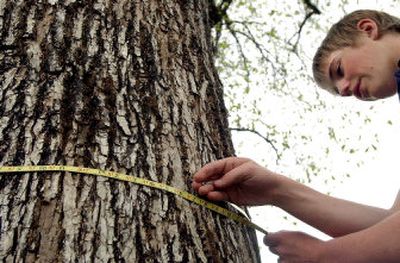CdA’s urban forest has roots from all over

Before the age of interstates and jet travel, transplants to Coeur d’Alene combated homesickness by planting trees.
The city’s old neighborhoods are lined with living souvenirs from former lives. There are sugar maples from New England, tuliptrees and red buds from Appalachia, giant sequoias from California and dozens of other species that had no prior place in the soils of North Idaho.
Many continue to thrive, sometimes against all odds, including towering weeping birch trees on the lawn of the courthouse. In part because of their isolation, the trees have managed to survive insect epidemics that have killed off forests of birch surrounding Lake Superior.
There’s also the unexplainable cucumber magnolia that towers 77.4 feet above Yates Funeral Home on Fourth Street. The tree’s exact measurements have been tracked over the past decade thanks to volunteers with the city’s Urban Forestry Committee, which publishes a brochure detailing Coeur d’Alene’s most unusual and storied trees.
Volunteers have been revisiting each of the trees this week to update their measurements and learn what they can about the stories behind them. New brochures are expected to be published this fall, said John Schwandt, a U.S. Forest Service tree health specialist and forestry committee member.
No other cucumber magnolias are known to live in Idaho, Schwandt said. The species grows best in warmer climates in Eastern states. Researchers can’t quite figure out why this particular tree has thrived since it was planted by Charlie and Sada Pellum about 85 years ago.
Dexter Yates, whose family bought the funeral home in the early 1950s, said the massive tree is messy – downed leaves and debris must be swept daily – but he has no plans to get rid of it. “We’ve got too much invested in a vacuum sweeper,” Yates said, laughing.
The big messes are a small price to pay for the old trees’ beauty, said Dan Martin, whose 901 Lakeside Ave. home is shaded by a sprawling sycamore, or London plane tree. The smooth-trunked tree was planted in 1907 by Charles Feil, Martin’s great-grandfather and a former mayor of Coeur d’Alene, and its canopy now shrouds the house.
On a single day in fall, Martin said he can easily fill 25 large trash bags with sycamore leaves. Branches fall on the house and roots clog sewer pipes. But Martin wouldn’t dream of having the tree removed.
Coeur d’Alene’s urban forester, Karen Haskew, hopes the attention given to these unusual trees will inspire residents to be creative in what they plant. A recent survey revealed that nearly 60 percent of the city’s trees are maples. Should a maple-specific disease or insect strike (think Dutch elm disease), the city could lose its shade in a matter of weeks.
Earlier residents took chances and planted relatively obscure tree species from their home states.
Three old American chestnut trees growing in City Park were lucky to be far from the 1904 fungus epidemic that killed most of the trees east of the Mississippi. They were probably planted here by a former resident of an Appalachian state, Haskew said. The same is likely true for a cluster of table mountain pines growing at 1201 Lakeside Ave. “That’s a tree I just can’t imagine a nursery selling. Those trees meant home to somebody,” Haskew said.
In summer, many downtown neighborhoods are canopied by the old trees, turning the streets into cool, green tunnels. This stands in contrast to many newer developments and businesses, where the old trees are felled to make way for houses and parking lots.
“It is important to realize that when we do cut down trees for progress, that’s an environmental loss as well as an aesthetic one,” Haskew said.
Copies of the city’s unusual and historic tree guide are available at City Hall or online.